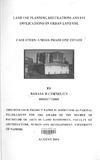| dc.description.abstract | The rationale of land use planning as a public function is to ensure economic efficiency in the use of space and to ensure that the health, safety and general security of the citizens of a country is promoted and secured.
Land use planning regulations in Kenya have failed to influence land development patterns in the rapidly growing urban areas. Kenya’s experience reveals lack of official government intervention and established procedures in formulating rules for allocation of land, control, approval and regulation of urban development. Evidence in Kenya shows the inability of land use planning regulations to hinder the occurrence of the problems associated with contemporary land use activities.
This study focuses on land use regulations with reference to Umoja one estate. Umoja one estate was initially targeted for low income earners but currently it has been occupied mainly by middle income earners. The main objective of this study was to find out the reasons behind continuous increase of unplanned developments which have not been approved by the Nairobi City Council.
It is evident that NCC has failed to implement land use planning regulations within its area of jurisdiction. As a result, informal settlements have continued to mushroom due to: inadequate man power, to implement land use planning regulations, inadequate finance, corruption and laxity among the NCC officials, lack of community participation and political interference in the council’s activities.
Effective reforms therefore need to be implemented and ways in which land use planning regulations could be made more efficient be examined so as to achieve planned and sustainable urban development.
Field study included interviews and questionnaires which were administered to residents, developers and NCC Planning officials. Visual observations and photographs were also used to give visual aspects of the buildings and other visible activities taking place within the area of study. | en_US |



